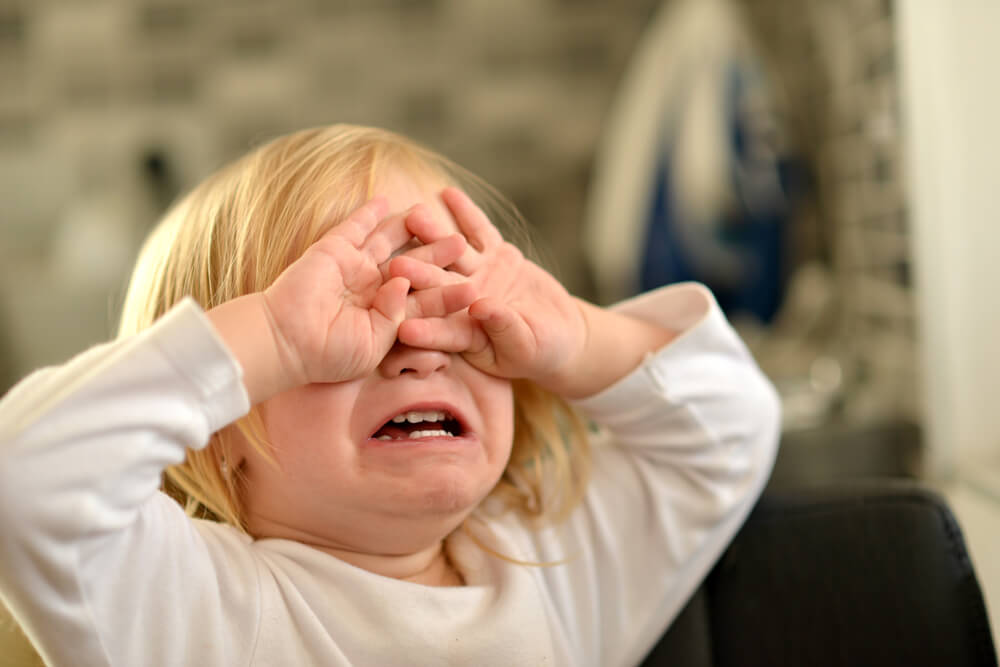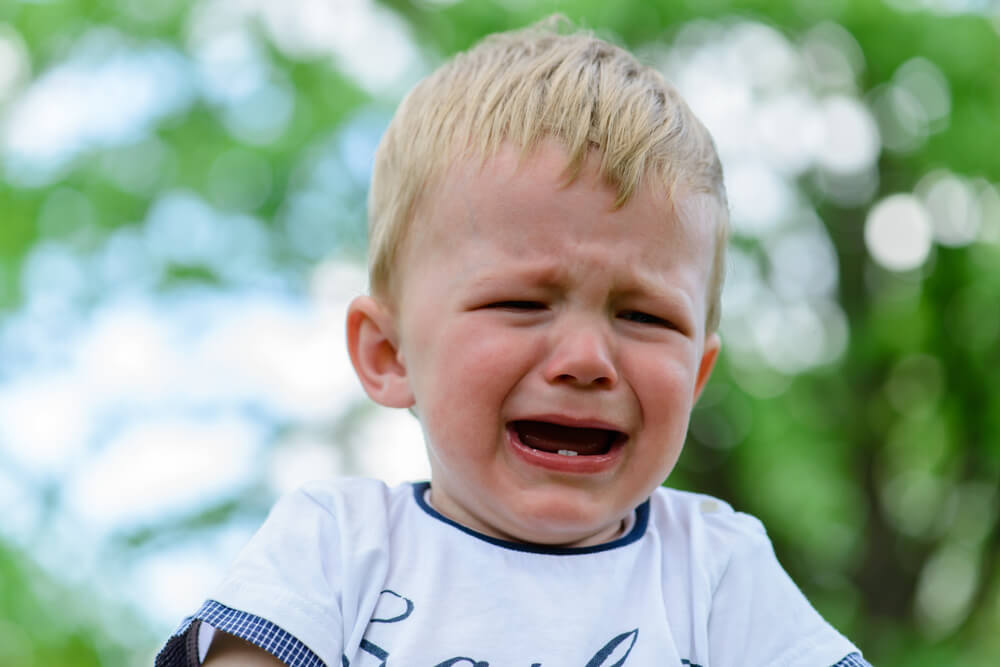Toddler Tantrums: What They Are and How to Handle Them?

Toddler tantrums are something that almost every parent has to deal with at some point or another. They’re a normal part of the growing process, but it’s perfectly natural to have questions about how to cope with them and what to do when your little one starts losing their calm. Here, we’ll look at what toddler temper tantrums are and how to handle toddler tantrums correctly.
Contents:
- What Is a Temper Tantrum?
- Are Temper Tantrums Normal Behavior?
- Why Do Tantrums Happen?
- What Goes On Inside The Toddler’s Mind When They Have a Tantrum?
- What Are the Signs of a Temper Tantrum?
- Can Tantrums Be Prevented?
- What’s the Best Way to Respond to a Tantrum?
What Is a Temper Tantrum?

Источник фото: Anna Kraynova/shutterstock.com
A temper tantrum is when a young child gets excessively angry and emotional. They may act out, cry, yell, kick, hit, bite, throw things, and display a range of other unpleasant and undesirable behavior. Often, another distinguishing characteristic of a temper tantrum is when your toddler gets extremely emotional over something that seems quite minor.
For example, you could be shopping at the supermarket with your child and they want to grab and eat one of the treats on the store shelves. You tell them that they can’t eat the treat and put it back, and they respond with tears, yelling, and violence. For you, the situation appears to be quite a simple and minor one, but to the child, it appears far more important and influential on their mood.
Are Temper Tantrums Normal Behavior?
This is one of the most common questions parents have about temper tantrums. Many moms and dads worry that they are doing something to trigger the tantrums. Others worry that their child could have an emotional or mental disorder to cause such extreme mood swings.
However, the truth of the matter is that temper tantrums are very normal. In fact, statistically speaking, temper tantrums are one of the most common behavioral problems witnessed by parents in young children.
a University of Wisconsin study confirmed this, looking at 1,219 families in total and finding that 87% of children had temper tantrums before reaching the age of 2. The study also found that 91% of children aged between 30 and 36 months had tantrums, too.
So, if you’ve ever worried that something is wrong with you or your child during a tantrum, you should know that you’re not alone. And it’s highly likely that your child is perfectly normal and just going through the same emotional stage as countless other toddlers around the world.
Why Do Tantrums Happen?

Источник фото: Halfpoint/shutterstock.com
So what causes tantrums and why do toddlers get so angry and emotional over issues that seem small?
The main explanation for these emotional moments is simply that your child is feeling frustrated and angry about not getting to do exactly what they want.
It’s important to remember that young children see the world in a different way. They’re still very young and learning about life, so even if something seems small to you – like not letting your little one eat a snack at the supermarket or asking them to tidy their toys away – it can seem much bigger to your toddler.
This can cause them to act out. In addition, since they’re still so young and not able to clearly express themselves with words, they often resort to actions like yelling and throwing things around. This can all be exacerbated by the child feeling tired, hungry, or ill, too, just like how older kids and even adults may be more prone to losing their temper when they’re having a bad day.
Age: When Do Tantrums Start? At What Age Should A Child Stop Having Tantrums?

Источник фото: christinarosepix/shutterstock.com
So, when can you expect to start seeing your little ones having these kinds of meltdowns and start screaming for no obvious reason? Well, it can vary from person to person. Some parents report that their kids had tantrums very early, while others don’t notice the first meltdown until quite late on.
In general, these tantrums will start occurring in children aged between 12 and 18 months. This is when young children start moving around and doing more things but don’t have the language skills needed to express themselves. So they’re more likely to express themselves physically.
In terms of when children stop having tantrums, this can also vary. Some parents have to deal with tantrums for several years, but some children grow out of them quite quickly. In general, you can expect kids to stop having tantrums around the age of 4 or 5.
Reasons and Causes of Tantrums
There are lots of possible causes of temper tantrums in children. Here are just a few of the most common triggers of these emotional outbursts:
- Wanting attention from their parents or someone else and not getting it.
- Wanting something, like a treat, a toy, or the freedom to play.
- Not wanting to do something they’re being asked to do, like tidying up or going home after visiting a playground.
- Feeling very hungry or thirsty.
- Feeling tired or sick.
Ultimately, a lot of temper tantrums are based around a child feeling frustrated or angry for some reason and not having the coping skills to deal with what’s happening, or the language skills to talk about their feelings.
Do Young Children Have Tantrums on Purpose?

Источник фото: Leon Rafael/shutterstock.com
Temper tantrums aren’t pleasant for anyone, including children. If a child is having a tantrum, it usually means that they’re feeling angry, sad, upset, or frustrated about something.
Therefore, in general, children do not intentionally have tantrums to try and embarrass their parents or get something out of them; they’re just lashing out due to their anger.
However, if you have an older child (4+) who is still having tantrums on a regular basis, there’s a possibility that this could be intentional to some degree. If you’ve always given in to your child during a tantrum and given them what they want, they may have learned that having tantrums is an effective method to get their own way. So this is something to watch out for in older kids.
If My Child Throws a Tantrum, Does That Mean I’m a Bad Parent?
Not at all. As stated above, almost every parent has to deal with temper tantrums at some point or another. They’re a normal part of a young child’s development, and they’re not a sign of bad parenting.
Tantrums simply happen because of your child’s emotions and the situations they find themselves in.
They’re perfectly normal and can be a valuable learning experience, teaching kids how to deal with negative feelings.
What Goes On Inside The Toddler’s Mind When They Have a Tantrum?

Источник фото: muroPhotographer/shutterstock.com
Looking at tantrums from a scientific point of view can help you develop a better understanding of what they are and how they work. So, here’s a quick and simple scientific breakdown of what happens inside a child’s mind during a tantrum.
When the child feels a lot of stress, caused by frustrating issues in their environment, a part of the brain called the amygdala is triggered. The amygdala is strongly associated with emotions and stress, and if it gets triggered or stimulated, it starts the release of stress hormones.
These hormones flow through the child’s bloodstream throughout their body, intensifying their emotions. All of those hormones cause a lot of internal anguish and emotional pain.
Usually, in older children and adults, we use the thinking part of our brains (prefrontal cortex) to deal with those emotions. But, in young children, the prefrontal cortex is not at all developed. This makes it hard for the toddler to handle their feelings, so they lash out in any way they can think of.
What Are the Signs of a Temper Tantrum?
There are many possible signs to watch out for that signify your child is having or about to have a tantrum:
- They may begin to cry or whine.
- They may raise their voice, yell, or shout.
- They can become physical and may start hitting, pinching, or biting you or others.
- They can start swinging their arms and legs around angrily.
- They may hold their breath.
- Their muscles may feel very tense and stiff.
- Their body may also go completely limp and they may fall to the floor.
Every child is different, and when you’ve seen your child have a couple of tantrums, you’ll start to recognize the signs more easily.
Can Tantrums Be Prevented?

Источник фото: Carolyn Dietrich/shutterstock.com
To a degree, yes, it is possible to prevent some temper tantrums, but probably not all of them.
It’s almost impossible to create an environment in which toddlers never get overly angry or upset.
However, there are steps you can take to reduce the frequency of tantrums and minimize the risk of a tantrum occurs. Here are a few strategies to try out.
HALT
The HALT method is one to keep in mind when you’re dealing with a toddler who could enter a tantrum at any moment. HALT stands for Hunger, Anger, Lonely, and Tired.
These are four major factors that can make a child much more likely to throw a fit, and they’re also four factors that you have some control over. You can create routines and responses to help your child avoid feeling too hungry, angry, lonely, or tired.
Transitions
It’s common for temper tantrums to happen during transitions. A transition is when the toddler moves from one state to another, such as leaving the house or having to go to bed in the evening.
One thing that parents can do is build gradually towards these transitions. Let your child know that a transition is coming and give them time to get ready for it. If you’re playing at the park, for example, don’t just suddenly leave without notice; let your child know that you’ll be leaving soon and give them time.
Choice
The choice is something else that can really help reduce the risk of tantrums. After all, many tantrums occur because children feel like they don’t have a choice and are being forced into an unpleasant or unwanted situation.
Giving them a choice allows them to have some level of control over a situation, which they will usually appreciate. For example, if your child is getting angry about not being allowed to eat multiple snacks, give them a choice between two and let them pick one.
What’s the Best Way to Respond to a Tantrum?

Источник фото: Katya Shut/shutterstock.com
There are many different ways in which you might respond or react to a temper tantrum. Usually, the best method is to try and keep as calm as possible.
If you respond to an emotional outburst by getting overly emotional yourself, this can just make the whole situation even worse. Shouting at your child may also exacerbate the situation, so it’s best to respond with calmness and a clear mind.
However, the right method can vary, depending on the situation. For example, if your child is having a tantrum in public and engaging in dangerous behavior, like running away from you in the street or hitting out at strangers, you’ll need to be more active in your response and physically hold onto the child until they calm down. Here are some dos and don’ts of responding to tantrums.
- Keep Calm. As stated above, calmness is really important when dealing with toddler tantrums. Don’t let yourself get emotional or lose your temper, as this could interfere with your judgment and set the wrong example for your child.
- Don’t Give In. One of the worst things you can do when your child has a tantrum is to give in and let them have whatever they wanted in the first place. This teaches the child that it’s fine to yell and scream, and it can be a great way to get what they want, so it may lead to more and more negative behavior in the future.
- Use Redirection. Trying to talk your child out of a tantrum while it’s happening can be difficult, but one method you may use is redirection. This means trying to redirect your child’s focus onto something else and make them forget about or move on from the thing that made them angry. For example, distract them with a book, a funny face, a song, or a story.
- Be Consistent. It’s important for parents to be consistent in how they respond to tantrums. If you respond in a clear and calm manner each time, your child will learn more quickly that tantrums are not an effective way to solve difficult situations.
- Timeouts. Some parents use timeout spots when kids are acting out. You can send the child to a seat in a corner or out into the hallway until they calm down. Sometimes, this can be an effective way to simply let the tantrum run its course, and the child should usually move on from their emotions in a matter of minutes.
- In Public. How to deal with temper tantrums in public? Well, in general, you should use the same approach you would use at home. Don’t let the eyes of other people make you feel embarrassed or change your parenting approach. Keep calm, use redirection, and move to another place to help your child calm down if needed.
Is Ignoring Toddler Temper Tantrums A Good Strategy?

Источник фото: Vaillery/shutterstock.com
Ignoring can be a very effective strategy, yes. This is especially true if kids start getting emotional when they can’t have something, like a treat or toy. By ignoring the tantrum, you can teach the child that yelling and screaming are not the way to get what they want and won’t change anything.
At the same time, ignorance should not be your No. 1 strategy in every situation. Remember, a tantrum can be a sign that your child is feeling tired, hungry, or even sick, so it’s important to pay attention to them and lookout for these signs so you can take the right action.
What to Do After a Temper Tantrum?
After a tantrum has ended, that’s the best time to talk to your child about what happened and why they got so angry. Once they’ve calmed down, they’ll be more likely to engage with you and respond adequately to your questions. You can then work out ways to stop tantrums from happening again in the future.
Make sure to acknowledge their feelings and let them know that you understand. Offer to help them and teach them more about emotions so that they can start to describe and explain things like anger and jealousy when they experience them. Offering praise when your child calms down is also a good way to reinforce positive behavior.
Respond the Right Way to Reduce the Risk of Temper Tantrums

Источник фото: smspsy/shutterstock.com
Temper tantrums are perfectly natural and will almost inevitably happen with every toddler, but it’s up to you, as a parent or guardian, to choose how you’re going to respond. Responding the right way, with calmness and clarity, can make a real difference and help to reduce the risk of tantrums as your child grows up.
Share this guide around with parents you know who may need help handling their toddler’s tantrums.
Picture on front page: Mariia Ts/shutterstock.com
Проверьте электронный ящик



















